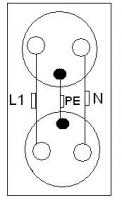Hello
I was looking for a pictorial diagram of fuse connections in the home electrical system.
I took some time and drew a diagram, which if it is good, I hope it will be useful to others who will have questions on this topic.
I want someone to say whether the diagram is correct and whether the wires go in and out where they should be and whether with this setting everything will work when it should. The question concerns mainly the wires that go from the differential to the next fuses. Should they enter from the bottom as I drew or from the top.
waiting for suggestions.
I was looking for a pictorial diagram of fuse connections in the home electrical system.
I took some time and drew a diagram, which if it is good, I hope it will be useful to others who will have questions on this topic.
I want someone to say whether the diagram is correct and whether the wires go in and out where they should be and whether with this setting everything will work when it should. The question concerns mainly the wires that go from the differential to the next fuses. Should they enter from the bottom as I drew or from the top.
waiting for suggestions.






